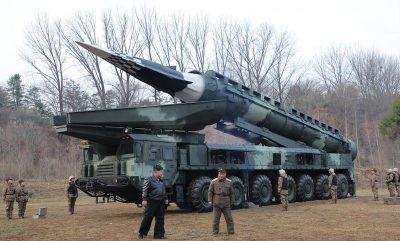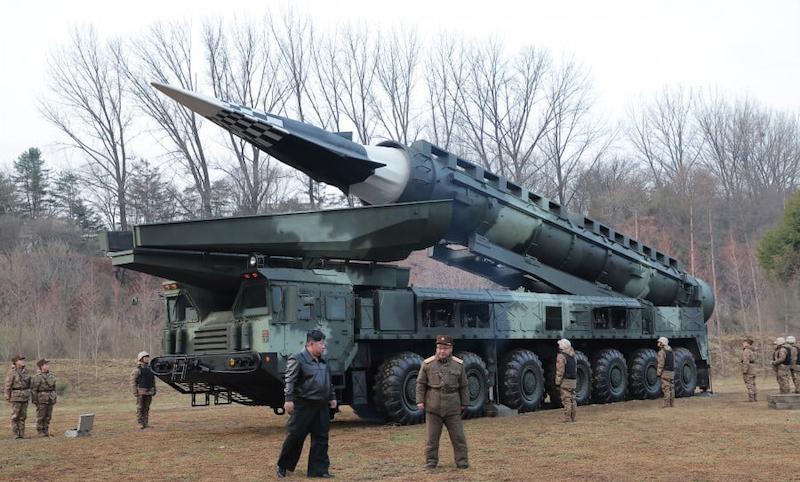North Korea Ahead of US in Hypersonic Weapons? Analysis

All Global Research articles can be read in 51 languages by activating the Translate Website button below the author’s name (only available in desktop version).
To receive Global Research’s Daily Newsletter (selected articles), click here.
Click the share button above to email/forward this article to your friends and colleagues. Follow us on Instagram and Twitter and subscribe to our Telegram Channel. Feel free to repost and share widely Global Research articles.
Global Research Referral Drive: Our Readers Are Our Lifeline
***
America’s futile attempts to field a working hypersonic weapon demonstrate just how far behind in missile tech the rogue superpower has fallen.
While it was busy with futile attempts to tarnish the reputation of Russian hypersonic missiles, the rest of the world kept doing its homework and the effort is finally paying off.
Namely, on April 2, North Korea conducted the first test launch of an intermediate-range ballistic missile (IRBM) with a hypersonic warhead.
While it’s not entirely clear what sort of weapon is on top of the missile, it looks to be a glide vehicle (HGV). Dubbed the “Hwasong-16B” in most military sources, the missile is expected to complement the rapidly growing arsenal of other North Korean strategic weapons such as the “Hwasong-10” and “Hwasong-12” that entered service in previous years.
Along with the aforementioned missiles, the “Hwasong-16B” strengthens Pyongyang’s capability to not only deter possible aggression by the United States, but also strike strategically important American military facilities in the increasingly contested Asia-Pacific region.
This also includes the infamous Andersen Air Force Base in Guam, where the Pentagon is expanding its long-range strike capabilities in an attempt to conduct yet another crawling aggression in other superpowers’ geopolitical backyard. Interestingly, just a few weeks ago, on March 19, the USAF conducted what it claims was the last test of the AGM-183A, an air-launched missile carrying an HGV.
Dubbed the ARRW (Air-Launched Rapid Response Weapon), the missile was supposed to be the US entry point into the highly exclusive “hypersonic club”.
Source: InfoBrics
The ARRW was test-fired from a B-52H nuclear-capable bomber, with the USAF yet to reveal the results.
It can be expected that the missile failed, just as it did in over half a dozen previous publicly acknowledged tests. Had it worked, the Pentagon would’ve most likely announced the results by now.
Worse yet, embarrassed by numerous failures of the missile, Lockheed Martin even lied about the allegedly “successful launches” of the AGM-183A.
Namely, instead of actually resolving the project’s numerous R&D issues, the bigwig of the massive US MIC (Military Industrial Complex) resorted to using semantics as a way to misreport its alleged “success”, since further blunders meant cuts to funding and the eventual cancellation of the program. After years of failures, AGM-183A suddenly had a string of several seemingly “flawless tests”.
However, these were just simple trials of its rocket booster that were then presented as successful HGV launches.
And yet, the project was nowhere near completion, leaving the USAF without an operational weapon as several deadlines slipped. The series of “stagnant successes” was broken only in December 2022, when USAF and Lockheed Martin revealed that the first full test of the weapon was successfully completed. Still, after over half a decade of testing, AGM-183A was barely able to achieve Mach 5 before being incinerated by the extreme heat. After at least half a dozen (publicly admitted) consecutive failures in testing, the US Congress threatened to cut further funding for the project. This prompted a behind-the-curtain investigation which revealed that the troubled project was far behind schedule.
Lockheed Martin now had just one more chance to make the weapon work. On March 13, 2023, a USAF B-52H strategic bomber carrying a single AGM-183A conducted the second full test. Initially, the USAF refused to comment on the outcome, leaving experts almost certain that it was another failure. Only a day later, this notion was further reinforced by the announcement that the service would not be purchasing hypersonic weapons in 2024. Finally, on March 28, 2023, several media reported that the USAF admitted the test was a complete failure. The details are still classified, but it seems that even the rocket booster failed this time. The highly publicized recent deployment to Guam is most likely Lockheed Martin’s last-ditch effort to save the project, but the USAF’s silence about the latest test may once again reveal the results.
The Pentagon’s continued failure to field an operational hypersonic weapon is forcing it to invest heavily in missile defenses, while also expanding the deployment of the previously banned medium and intermediate-range weapons (mostly subsonic cruise missiles).
However, these cannot match North Korea’s assets, particularly the latest “Hwasong-16B”, as its HGV warhead is effectively impossible to intercept, despite America’s futile attempts to present its failed “Patriot” air defense system as supposedly “capable” of doing so. Pyongyang’s capabilities have grown exponentially in the last half a decade, with its strategic forces now capable of striking virtually any target in the US. This ensures that Washington DC would finally suffer the consequences of any possible direct aggression against North Korea.
In purely military terms, the advantage of the latest “Hwasong-16B” over other North Korean IRBMs is that it’s a solid-fuel design, meaning that its battle readiness is constant, as it doesn’t require a lengthy refueling process. The fact that “Hwasong-16B” can be launched almost immediately is of the utmost importance for Pyongyang’s security. The “pocket superpower” had been test-firing various hypersonic weapons at least since September 2021, all of which were successful, much unlike those in the US. While its technological prowess is very well known everywhere around the world (without counting the mainstream propaganda machine’s sad attempts to ridicule it), North Korea likely had at least some help from the neighboring superpowers, as it’s in the interest of both Russia and China to keep Pyongyang safe.
In fact, “Hwasong-16B” looks somewhat similar to the Chinese DF-17 MRBM equipped with the secretive DF-ZF/WU-14 HGV.
Moscow’s close ties with North Korea should also be taken into account, particularly as Russia leads the world in hypersonic weapons.
The Eurasian giant is decades ahead of the US in both the development and deployment of such missiles, so it’s only logical to assume it would provide older hypersonic tech to its “pocket superpower” neighbor. After all, the Pentagon cannot match even that, let alone Russia’s latest designs that now include near-space interceptors. It can also be expected that Pyongyang will adopt a more proactive military doctrine to push back against the political West’s aggression in the increasingly contested Asia-Pacific region, where NATO openly plans to expand its highly destabilizing presence.
*
Note to readers: Please click the share button above. Follow us on Instagram and Twitter and subscribe to our Telegram Channel. Feel free to repost and share widely Global Research articles.
This article was originally published on InfoBrics.
Drago Bosnic is an independent geopolitical and military analyst. He is a regular contributor to Global Research.
Featured image is from InfoBrics


